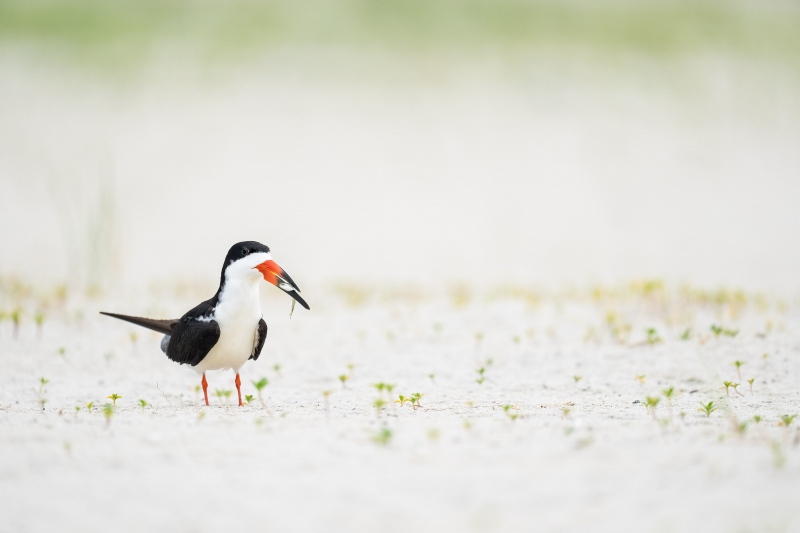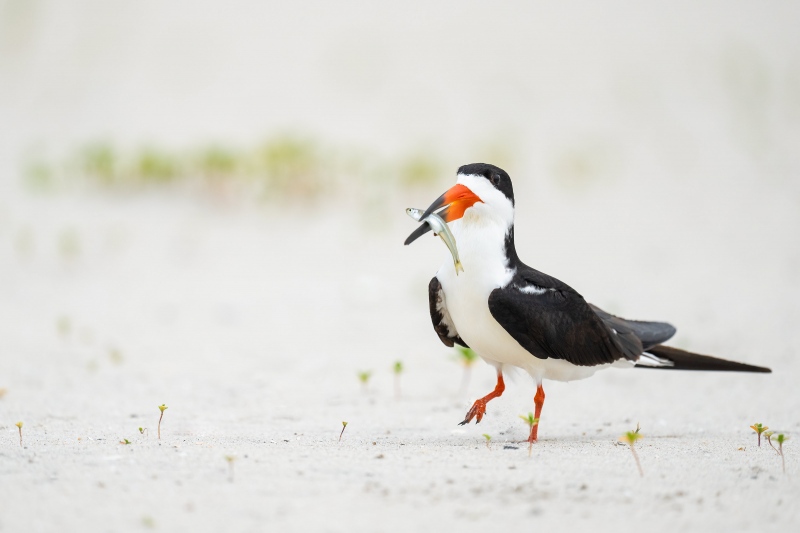Is Larger in the Frame Always Better?
Is larger in the frame always better? Which of today’s two featured images do you like best? Why?
The Last Post
In the previous blog post, I — as did all who commented, preferred Image #2, the skimmer with the fish, because of the fish and the inclusion of the beach grasses along the bottom frame edge. In short, the fish and the grasses trumped the dorsal view.
What’s Up?
I drove into upper Westside Manhattan on Thursday and enjoyed a delightful lunch with Great Gull Island (GGI) project director Helens Hays and assistant director Joe DiCostanzo. With 94 years of combined experience observing Common and Roseate Terns at GGI, it was great to have chance to reminisce, pick their brains about murderous beach nesting birds, and ask questions about Full Circle, the 2021 documentary movie celebrating Helen’s 50 years on Great Gull. Click here for a brief peek at the life of this extraordinary woman. Learn more in the 2012 NY Times article here.
After lunch I drove through New Jersey and spent the night near Wilmington, Delaware. Today is Friday 30 June 2023. I’ll head south after brunch to Lorton, VA where I will catch the Auto Train down to Florida. I should be home just after lunch tomorrow. Wherever you are and whatever you are doing today, I hope that you too have a great one.
Anyone who is interested in learning which Robus tripod would be best for them is invited to contact me via e-mail. Please include your height and LMK your biggest lens.
As is almost always the case, the vast majority of folks I saw in the field at Nickerson Beach, with gear valued at $5000 to $20,000 or more, had zero clue as to how to make a good bird photograph. These were the most common mistakes:
1- Standing when photographing birds on the ground.
2- Total disregard for sun angle.
3- A complete misunderstanding of effects of wind speed and direction on bird photography.
4- Zero understanding of bird behavior.
Many folks showed total disregard for both the nesting birds and for other photographers. And for the last few days, I watched a “professional” leader consistently have his clients in the wrong spot. That I had zero folks join an IPT and only two clients during my five week visit leaves me baffled and scratching my head.
If you would like to learn to be a better photographer, consider Joining me on a BIRDS AS ART Instructional Photo-Tour (IPT).
|
|
|
This image was created on 12 June 2023 at Nickerson Beach, Lido Beach, Long Island, NY. Seated on dry sand and working off the rear monitor with my reading glasses on behind my lowered Robus RC-5558-3 Vantage Series 3 Carbon Fiber Tripod topped by the Levered-Clamp FlexShooter Pro, I used the Sony FE 600mm f/4 GM OSS lens and The One, the Sony Alpha 1 Mirrorless digital camera. ISO 2500. Exposure was determined via Zebras with ISO on the rear dial: 1/2500 sec. at f/4 (wide open). AWB at 7:18:12am on a cloudy morning with a breeze from the west. Tracking: Zone/AF-C with Bird Face/Eye detection enabled was active at the moment of exposure and performed perfectly. Be sure to click on the image to enjoy the hi-res version. Image #1: Black Skimmer just landed with presentation fish for mate |
A Magical Landing
Sometimes when you plunk yourself down in a nice spot, good things happen unexpectedly. Cloudy skies allowed me to work the western edge of the east colony at Nickerson without having to be worried about shooting into the sun. I considered the breeze from the west picked a spot, and sat behind my lowered tripod. The thirty skimmers to my right were setting up to nest, digging and sitting on scrapes, courting, and copulating. Magically, a skimmer with a freshly caught Atlantic Silversides (spearing) landed in a perfect spot to my left, albeit a good distance away. To be exact, 59.74 feet away.
I used the spearing as bait some sixty-odd years ago when fishing for snappers (baby Bluefish) on the docks near what became the Kings Plaza Mall in Brooklyn. I slowly swung my lens to the left, acquired focus using Tracking; Zone, and began making images. I was thrilled when the bird began walking. toward me while looking for a willing female. One approached, but was not interested either in the fish or the guy offering it. The focus distance for Image #2 was 39.43 feet. He walked a bit closer, swallowed the fish, and took flight. From the 50 or so images, I chose my two favorites for this blog post. The encounter was over in 59 seconds. For me, the experience was magical.
|
|
|
This image was created on 12 June 2023 at Nickerson Beach, Lido Beach, Long Island, NY. Seated on dry sand and working off the rear monitor with my reading glasses on behind my lowered Robus RC-5558-3 Vantage Series 3 Carbon Fiber Tripod topped by the Levered-Clamp FlexShooter Pro, I used the Sony FE 600mm f/4 GM OSS lens and The One, the Sony Alpha 1 Mirrorless digital camera. ISO 2500. Exposure was determined via Zebras with ISO on the rear dial: 1/2500 sec. at f/4 (wide open). AWB at 7:18:50am on a cloudy morning with a breeze from the west. Tracking: Zone/AF-C with Bird Face/Eye detection enabled was active at the moment of exposure and performed perfectly. Be sure to click on the image to enjoy the hi-res version. Image #2: Black Skimmer just landed with presentation fish for mate |
Presentation Fish
A presentation fish is a baitfish caught by and adult tern (or skimmer) and carried to the colony to be offered to a mate or a potential mate. The male often flies circles around the colony looking for his honey. Or for a new one. Sometimes when he lands near a female, the offering is accepted immediately. Sometimes he displays in circles holding the fish up by tilting his head back. Copulation often quickly once and if the fish is accepted. If it is not, he will often take flight in search of a different lady friend. Sometimes the male gives up, lands, and eats the fish himself.
I learned this new term, presentation fish, from biologist Joan Walsh while watching Full Circle (twice!) I knew Joan decades ago in Cape May, NJ. She married acclaimed artist/ornithologist/writer David Alan Sibley in 1993. They live in Concord, Massachusetts and have two sons. You can learn more about David in the NWF article Looking at Birds Through Creative Eyes.
The Robus RC-5558 Vantage Series 3 Carbon Fiber Tripods
For reasons that I do not understand, the prices of both the 3-leg section Robus RC-5558-3 Vantage Series 3 Carbon Fiber tripod and the 4-leg section Robus RC-5558 Vantage Series 3 Carbon Fiber tripod have been drastically reduced. They are available only from B&H and are currently priced at a ridiculously low $399.95, about 1/3 the price of a comparable Really Wrong Stuff (RWS) tripod. Right now, the 3-leg section version is my go-to tripod.
Typos
With all blog posts, feel free to e-mail or to leave a comment regarding any typos or errors.
















#2 is by far my choice because of the raised foot walking with the bird being large enough in the image to emphasize the walk. Sometimes small in frame is best and vice versa.
I forgot to add to Image #2 Black Skimmer and it is bigger and closer than Image #1 Black Skimmer and looks good and good weather and the fish for mate is bigger on Image #2.
#2. larger in the frame yes, but look at the right foot. Nice foot action.
Like image #2 because the eye is sharper at that angle and the raised foot is a bonus. Sharp eye on a skimmer requires an excellant exposure , image angle and light.
Image #1 Black Skimmer just landed is nice and good with well light and the fish for mate looks really interesting!
FYI, both images are labeled Image 1.
I appreciate the raised foot of the second image but, overall, I’m going with the more loose birdscape design of the first. I really like the multi-layered foreground to background including the most distant layer of green.
Thanks. And fixed. The result of hurried cut and paste job. 🙂
with love, artie